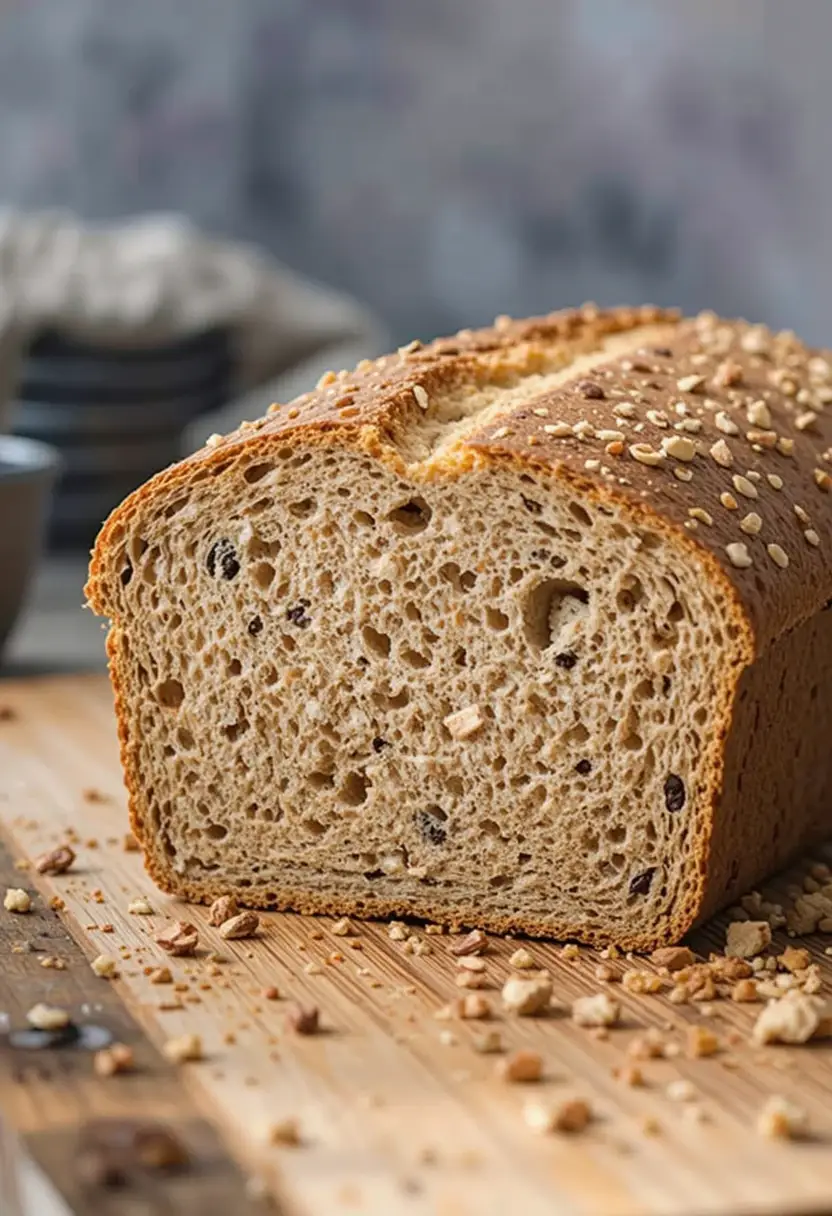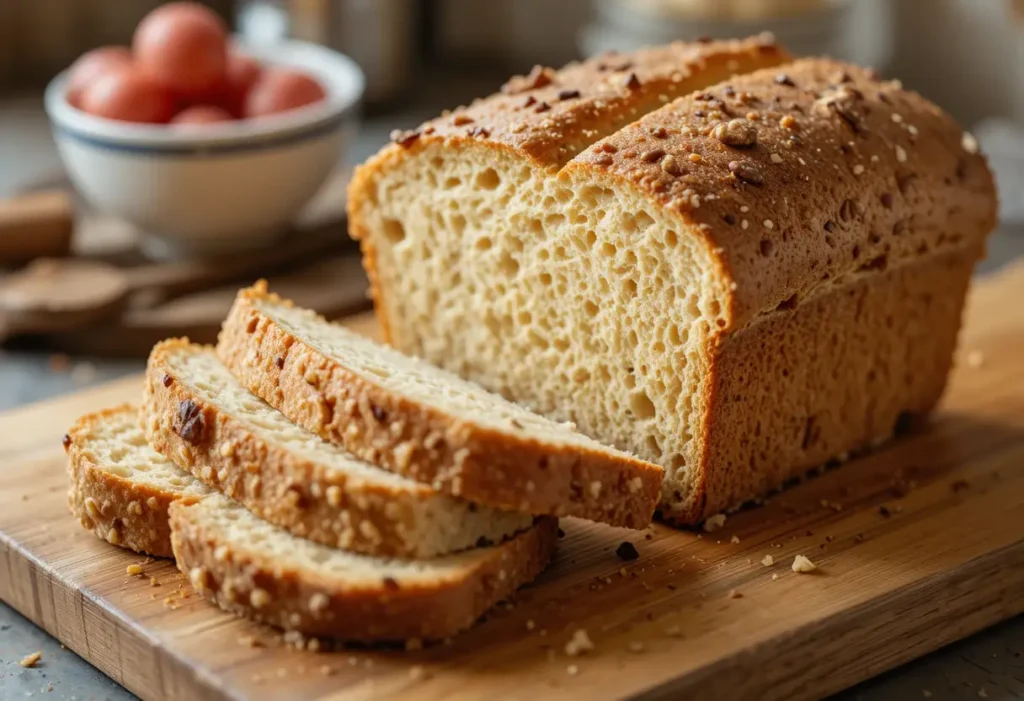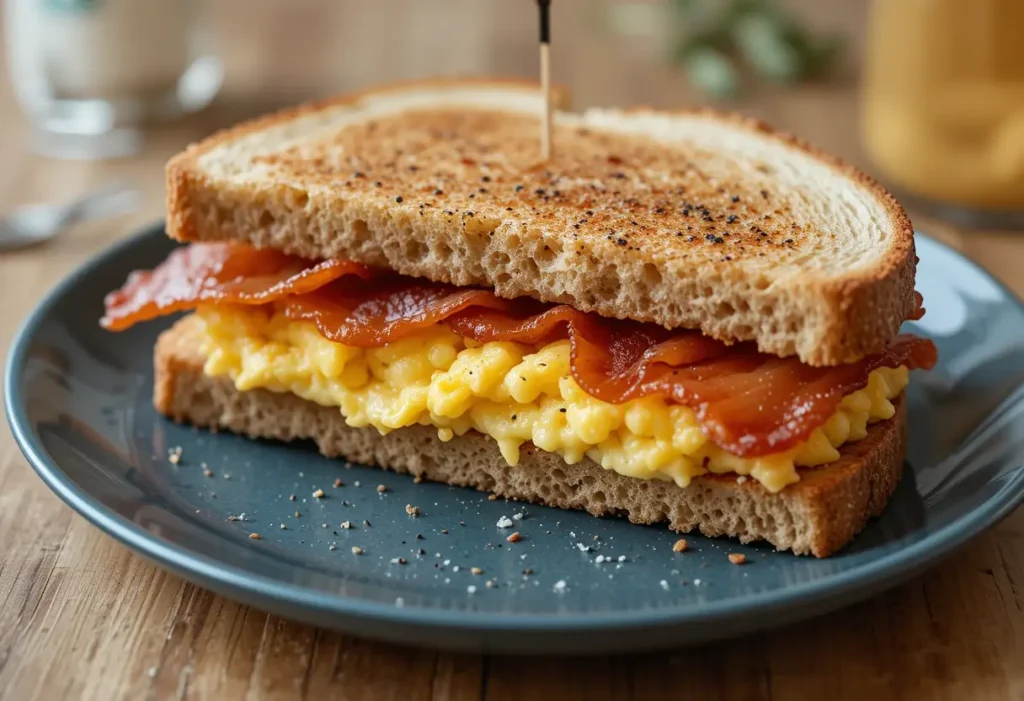Bread has been a staple in diets worldwide, but traditional loaves can be laden with carbohydrates, making them unsuitable for those on a low-carb diet. Enter low-carb bread—a versatile alternative that allows you to enjoy the comfort of bread without compromising your nutritional goals. Whether you’re following a ketogenic, paleo, or simply a low-carb lifestyle, low-carb bread recipes open up a world of delicious possibilities.
What Is Low Carb Bread?
Low-carb bread is a healthier version of traditional bread that replaces high-carb ingredients like wheat flour with alternatives such as almond flour, coconut flour, flaxseed, and psyllium husk. These ingredients are rich in fiber, healthy fats, and protein, making them an excellent choice for individuals looking to manage blood sugar levels, lose weight, or maintain overall wellness.
Unlike conventional bread, low-carb versions often skip or reduce the use of yeast and rely on other leavening agents like baking powder or egg whites to achieve the right texture and rise.
Table of Contents
Benefits of Choosing Low Carb Bread
- Supports Weight Management
Low-carb bread is lower in calories and carbohydrates, making it a great option for those trying to lose weight or maintain a healthy weight. It helps reduce hunger by keeping you fuller for longer, thanks to its higher protein and fiber content. - Improves Blood Sugar Control
By swapping high-carb bread with low-carb alternatives, you can avoid the rapid blood sugar spikes and crashes that come with traditional bread. This makes it especially beneficial for individuals with diabetes or prediabetes. - Fits Various Diets
Whether you’re on a keto, paleo, gluten-free, or general low-carb diet, low-carb bread can easily adapt to your dietary needs. It accommodates dietary restrictions while still allowing for versatility in meals. - Promotes Better Digestion
Many low-carb bread recipes incorporate ingredients like flaxseed and psyllium husk, which are high in dietary fiber. This can support digestive health and regular bowel movements. - Encourages Healthy Fat Intake
Ingredients like almond flour and coconut flour are rich in healthy fats, which are essential for brain function, energy, and satiety.
Low-carb bread is not just a compromise but a chance to elevate your baking skills while enjoying the best of both health and flavor. In the following sections, we’ll dive into must-try recipes, tips, and tricks to create the perfect low-carb bread for every occasion. Stay tuned!
Key Ingredients for Low Carb Bread
Low-carb bread relies on specific ingredients that replace traditional high-carb components. These ingredients not only reduce carbohydrate content but also improve texture, flavor, and nutritional value. Below is a detailed breakdown of the key ingredients, organized by their functional roles.
Flour Alternatives for Low Carb Breads
Flour alternatives form the base of low-carb bread. These substitutes mimic the texture of traditional flour while offering fewer carbs and more nutrients.
Almond Flour
- Quantity Guidelines: Often used as the primary flour in low-carb bread recipes, ranging from 1 to 2 cups.
- Key Features:
- Low in carbs (2 grams of net carbs per 1/4 cup).
- Adds a rich, nutty flavor and moist texture.
- Usage Notes:
- Requires binding agents to maintain structure.
- Works best in dense bread recipes like quick breads or muffins.
Coconut Flour
- Quantity Guidelines: Extremely absorbent, so typically only 1/4 to 1/3 cup is needed for a recipe.
- Key Features:
- Low in carbs (2 grams of net carbs per 2 tablespoons).
- Adds lightness and a slight coconut flavor.
- Usage Notes:
- Requires more liquid or eggs than other flours to prevent dryness.
- Often paired with almond flour for balance.
Flaxseed Meal
- Quantity Guidelines: Usually 1/4 to 1/2 cup in recipes, or combined with other flours for added texture.
- Key Features:
- Extremely low in carbs (0-1 gram of net carbs per 2 tablespoons).
- Acts as a natural binder while adding a nutty flavor.
- Usage Notes:
- Can replace eggs in vegan recipes when mixed with water.
- Enhances the fiber content and structural integrity of bread.
Binding Agents and Leavening Essentials
Binding agents and leavening ingredients ensure the bread achieves the right texture, rise, and cohesiveness.
Psyllium Husk Powder
- Quantity Guidelines: Typically 1-3 tablespoons per recipe, depending on the desired structure.
- Key Features:
- Zero net carbs.
- Provides elasticity and holds bread together.
- Usage Notes:
- Must be hydrated with sufficient liquid to prevent a gritty texture.
- Helps create a chewy, bread-like consistency.
Baking Powder and Baking Soda
- Quantity Guidelines:
- Baking Powder: Usually 1-2 teaspoons per recipe.
- Baking Soda: Typically 1/2 to 1 teaspoon when paired with an acidic ingredient.
- Key Features:
- Both are carb-free.
- Ensure a light and airy texture by releasing gas during baking.
- Usage Notes:
- Baking soda requires an acidic component (e.g., vinegar or yogurt) to activate.
- Do not overuse, as excessive amounts can affect flavor.
By understanding the quantities and roles of these ingredients, you can perfect your low-carb bread recipes and achieve the ideal balance of taste, texture, and nutrition.
Step-by-Step Recipe for Making Low Carb Bread at Home
Making low-carb bread at home can be a rewarding experience, allowing you to control the ingredients and tailor the bread to your dietary preferences. Follow these steps to achieve a loaf that is both delicious and nutritious.
Preparing Your Ingredients
- Choose Your Flour
Select a combination of almond flour, coconut flour, or flaxseed meal depending on your desired flavor and texture. For most recipes, a mix of almond flour and coconut flour works well to balance moisture and density. - Measure Precisely
Use a kitchen scale or measuring cups to ensure accurate quantities. Low-carb flours are sensitive to small variations, which can affect the bread’s texture. - Prepare Binding Agents
- Eggs: Beat the eggs lightly to improve incorporation.
- Psyllium Husk: Mix with water or other liquids as directed by the recipe to activate its binding properties.
- Check Your Leavening Agents
Ensure your baking powder or baking soda is fresh for optimal rising. - Preheat the Oven
Set your oven to the temperature specified in your recipe, usually between 325°F and 350°F (160°C to 175°C). - Line Your Pan
Use parchment paper or lightly grease your loaf pan with coconut oil or butter to prevent sticking.
Mixing Techniques to Get the Best Texture
- Combine Dry Ingredients
In a mixing bowl, whisk together your flours, baking powder, and salt. This ensures even distribution and prevents clumping. - Blend Wet Ingredients Separately
In another bowl, mix your eggs, melted butter or oil, and any additional liquids like almond milk or water. Add a splash of apple cider vinegar if using baking soda. - Gradually Combine Wet and Dry Ingredients
Slowly incorporate the wet ingredients into the dry mixture. Stir gently to avoid over-mixing, which can lead to a dense loaf. - Add Psyllium Husk or Other Binders Last
Quickly fold in the hydrated psyllium husk or xanthan gum, as these thicken rapidly. Work swiftly to ensure an even consistency. - Check Batter Consistency
The batter should be thick but spreadable. Adjust by adding a small amount of water or almond milk if it’s too stiff.
Baking Tips for Perfect Low Carb Bread
- Shape and Transfer the Dough
Pour the batter into your prepared loaf pan. Smooth the surface with a spatula for an even bake. - Monitor Rising
Low-carb bread doesn’t rise as much as traditional bread. Don’t worry if it seems flatter; this is normal due to the absence of gluten. - Bake Evenly
Place the pan in the center of the oven to ensure even heat distribution. Bake for 40-50 minutes, or until a toothpick inserted into the center comes out clean. - Check the Crust
If the crust browns too quickly, tent the bread with aluminum foil halfway through the baking time. - Cool Completely
Allow the bread to cool in the pan for 10-15 minutes, then transfer it to a wire rack to cool completely. This step is crucial to set the texture and prevent crumbling. - Store Properly
Wrap the bread in parchment paper and store it in an airtight container in the refrigerator for up to a week. For longer storage, slice and freeze individual pieces.
By following these steps, you’ll create a homemade low-carb bread that’s perfect for sandwiches, toast, or snacking. Enjoy the process and customize the flavors to suit your preferences!
Nutritional Information and Diet Compatibility
Understanding the nutritional content and compatibility of low-carb bread with various diets is key to maximizing its benefits.
Caloric and Macronutrient Breakdown
- Typical Low-Carb Bread Slice (Approx.):
- Calories: 120-150
- Fat: 10-12 grams
- Protein: 4-6 grams
- Net Carbs: 1-3 grams (depending on ingredients)
The exact values depend on the recipe and portion size, so always calculate based on your specific ingredients.
How Low Carb Bread Fits into Keto and Other Low Carb Diets
- Keto Diet:
Low-carb bread is an excellent choice for keto due to its high fat and low net carb content. It pairs well with high-fat toppings like butter, avocado, or cream cheese. - Other Low-Carb Diets:
Suitable for Atkins, Paleo, or diabetic-friendly diets. It provides a versatile bread alternative without spiking blood sugar levels.
Troubleshooting Common Baking Problems
How to Deal with Dense Bread
- Causes: Overmixing, incorrect ratios, or insufficient leavening agents.
- Solutions:
- Avoid overmixing the batter; fold ingredients gently.
- Add an extra egg or a bit more baking powder to improve lift.
- Ensure your baking powder or baking soda is fresh.
Solutions for Bread That Doesn’t Rise
- Causes: Expired leavening agents, too little acid (for baking soda), or low oven temperature.
- Solutions:
- Check expiration dates on baking powder and baking soda.
- Add a small amount of vinegar or lemon juice to activate baking soda.
- Use an oven thermometer to ensure accurate baking temperatures.
Advanced Tips for Low Carb Bread Bakers
Techniques for Achieving a Lighter Crumb
- Whip Egg Whites: Beat egg whites to stiff peaks and fold them gently into the batter for a fluffier texture.
- Add Acidic Ingredients: A splash of vinegar or lemon juice activates leavening agents, enhancing rise.
- Incorporate Carbonated Water: Replace some liquid with sparkling water to create a lighter, airier crumb.
Long-term Storage Solutions
- Refrigeration:
Store in an airtight container or wrap in parchment paper. Bread will stay fresh in the refrigerator for up to one week. - Freezing:
Slice the bread before freezing. Place parchment paper between slices and store in a freezer-safe bag. It can last up to three months. - Thawing and Reheating:
Thaw slices at room temperature or reheat in a 300°F (150°C) oven for a few minutes to refresh texture.
By mastering these techniques and troubleshooting strategies, you can consistently bake low-carb bread that meets your dietary goals while satisfying your taste buds!
Incorporating Low Carb Bread into Your Meals
Low-carb bread can be a versatile addition to your meals, offering endless possibilities for creativity and delicious options that align with your dietary goals.
Breakfast Ideas
- Avocado Toast
- Top toasted low-carb bread with mashed avocado, a sprinkle of salt, pepper, and chili flakes. Add a poached egg for extra protein.
- Breakfast Sandwich
- Layer scrambled eggs, crispy bacon, and cheese between two slices of low-carb bread for a hearty start to your day.
- French Toast
- Dip low-carb bread in a mixture of beaten eggs, almond milk, and cinnamon. Cook in a skillet until golden brown and serve with sugar-free syrup or fresh berries.
- Nut Butter Delight
- Spread almond or peanut butter on a slice of low-carb bread. Add sliced strawberries or chia seeds for a sweet, protein-packed option.
- Savory Breakfast Pizza
- Use toasted low-carb bread as a base and top with cream cheese, smoked salmon, and capers for a quick, elegant meal.
Lunch and Dinner Solutions
- Grilled Cheese
- Make a classic grilled cheese sandwich using your favorite low-carb bread and cheese. Serve with low-carb tomato soup for a comforting combo.
- Deli Sandwiches
- Use low-carb bread for a sandwich filled with turkey, lettuce, tomato, and avocado. Add mustard or mayo for a flavorful finish.
- Bread Bowl Soups
- Hollow out a loaf of low-carb bread to create a mini bread bowl. Fill it with a low-carb soup like creamy cauliflower or broccoli cheddar.
Conclusion
Recap of Low Carb Bread Benefits
Low-carb bread is a nutritious alternative, perfect for those on keto, paleo, or gluten-free diets. It’s versatile, fiber-rich, and supports overall health.
Encouragement to Try Baking at Home
With this guide, you’re equipped to create your own low-carb bread. To explore more recipes, check out the Pumpkin Banana Loaf for a seasonal twist or try the Coconut Bread Recipe for a tropical variation. For meal ideas, consider pairing low-carb bread with recipes like the Shrimp Burrito Wrap for a creative and satisfying dish.
Start baking and enjoy the benefits of delicious and healthy low-carb bread today!



